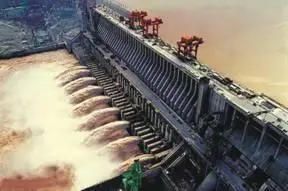Simon Foster - CHINA's Three Gorges & Xi'an
Здесь есть возможность читать онлайн «Simon Foster - CHINA's Three Gorges & Xi'an» весь текст электронной книги совершенно бесплатно (целиком полную версию без сокращений). В некоторых случаях можно слушать аудио, скачать через торрент в формате fb2 и присутствует краткое содержание. Год выпуска: 2010, Издательство: Hunter, Жанр: Старинная литература, на английском языке. Описание произведения, (предисловие) а так же отзывы посетителей доступны на портале библиотеки ЛибКат.
- Название:CHINA's Three Gorges & Xi'an
- Автор:
- Издательство:Hunter
- Жанр:
- Год:2010
- ISBN:нет данных
- Рейтинг книги:4 / 5. Голосов: 1
-
Избранное:Добавить в избранное
- Отзывы:
-
Ваша оценка:
- 80
- 1
- 2
- 3
- 4
- 5
CHINA's Three Gorges & Xi'an: краткое содержание, описание и аннотация
Предлагаем к чтению аннотацию, описание, краткое содержание или предисловие (зависит от того, что написал сам автор книги «CHINA's Three Gorges & Xi'an»). Если вы не нашли необходимую информацию о книге — напишите в комментариях, мы постараемся отыскать её.
CHINA's Three Gorges & Xi'an — читать онлайн бесплатно полную книгу (весь текст) целиком
Ниже представлен текст книги, разбитый по страницам. Система сохранения места последней прочитанной страницы, позволяет с удобством читать онлайн бесплатно книгу «CHINA's Three Gorges & Xi'an», без необходимости каждый раз заново искать на чём Вы остановились. Поставьте закладку, и сможете в любой момент перейти на страницу, на которой закончили чтение.
Интервал:
Закладка:
Three Gorges Dam Site ($135)
Whatever you think of the project, it's gone ahead and is being touted as the best thing to happen in China since boiled rice. I visited the dam site several times during its construction and every time was overwhelmed not only by its gargantuan scale, but also by its popularity with domestic tourists. At the site there's an exhibition detailing construction and with a grand model of the dam. You can ascend to a viewpoint where you can overlook the whole site. If you're lucky, your guide might be able to arrange for you to take a trip along the top of the dam itself (see picture below) – ask in advance and note that security is tight. You can also visit the dam site from Yichang by minibus or bus #8, which takes around an hour and costs $25.

Three Gorges Dam Project
Throughout history, China's great rivers and particularly the Yangzi, have been both a blessing, bearing fertile soils and transport, and a curse, bringing floods, destruction and death. Since the time of Yu, Tamer of Floods (see Xia Dynasty ), the Chinese have been trying to reap the river's rewards, while minimizing its catastrophes, but the first serious talk of damming the river didn't come until the 20th century. Initially deemed impossible, plans were finally put into motion in 1994, and quickly provoked international condemnation on several fronts – namely damage to the environment, the human cost, the catastrophic risks if the dam fails, and the claim that the dam won't effectively serve its purpose of flood prevention throughout the region.
Fast Facts:
Cost: US$24 billion and counting
Number of workers: 40,000
Number of people re-located: 1.2 million
Length of dam: 1.4 miles
Height: 607 feet
Hydro-electric capacity: 19 gigawatts (10% of China's requirements)
Number of Locks: Five, plus the world's biggest ship-lift
Water-level rise: 400 feet across the Three Gorges
Many experts believe that the best way to address flooding along the Yangzi would be to build several smaller dams, but the energy needs and grand project mentality of the government has brushed these aside in favor of the biggest construction feat in China since the Great Wall. The dam is in a tectonic fault zone and, although it has been designed to withstand missile attack, the appearance of cracks along its walls has done little to reassure skeptics. Even if all these fears are unfounded there are further worries that the lake will silt up in a matter of decades – the river at Chongqing is already suffering from increased sedimentation and the government recognizes that it will need to address the problem. In spite of all these concerns, the coffer dam was demolished in 2006 and the project is now way past the point of no return. However, for all the negatives there are a few positive points. First, the dam should prevent the loss of thousands of lives to flooding; second, it provides a renewable source of energy which will reduce reliance on fossil fuels; and third, the dam allows the Yangzi to be safely navigable, even by large vessels, for the first time in human history.
Human & Cultural Costs
In order to construct the dam and create one of the world's biggest man-made lakes, over a million people have been forced to relocate – a gargantuan task in itself. Many of these people have lived in the same villages and towns all of their lives and are unsure how they will cope with relocation. One of the most heartbreaking things I've seen in my time in China is people demolishing their own homes along lowlying stretches of the river. The Yangzi valley is one of the cradles of civilization in China and there are also thousands of unearthed historic relics that will be lost forever. Only one percent of the dam project's budget is allocated for the protection of cultural relics, but 10,000 workers are frantically excavating 600 sites, racing against the rising water level to uncover as much as possible before it's too late. Artifacts are being found faster than they can be catalogued, but for every piece which makes its way to the new
Three Gorges Museum
in Chongqing, an untold number of treasures will be lost.
Environmental & Economic Costs
Beyond human and cultural effects, the dam will also irrevocably alter the ecosystem and affect the creatures living within it. Animals such as the Chinese alligator and Yangzi River dolphin (see Flora & Fauna ) were already struggling for survival and the dam looks set to seal their fate. Furthermore, some of the area's inherent natural beauty will be lost and, although plans are afoot to develop designated tourist zones, there are fears that the lake will become a giant sludge-pool of polluted water. Over a million visitors traveled along the Three Gorges in 2004 and, despite government claims to the contrary, these numbers are expected to decline. If they do, the region will lose an important sector of its economy.
Yichang
Yichang is a small city on the north bank of the Yangzi which would see few visitors were it not the terminus for the Three Gorges cruise, and the nearest city to the gigantic dam 22 miles west at Sandouping. Most tourists arrive by boat from Chongqing, but you can also start the Three Gorges cruise upstream from Yichang, which takes fractionally longer. Chances are you won't need to stay in Yichang, but if you do you'll find reasonable hotel rates and a pleasant, if unexceptional small city.
Getting Here & Away
By Air
Taxis cost around $60 to the airport, which is six miles east of town.
Flight details from Yichang
Beijing(2 daily, 2 hrs); Chongqing(1 daily, 50 mins); Guangzhou(2 daily, 1 hr 40 mins); Shanghai(1 daily, 2 hrs); Shenzhen(1 daily, 1 hr 30 mins); Xi'an(1 daily, 1 hr 10 mins).
By Rail
The train station sits on a hill immediately above Dongshan Dadao.
Train details
Beijing(1 daily, 20 hrs); Guangzhou(3 daily, 15-23 hrs); Hangzhou(1 daily, 27 hrs); Nanjing(1 daily, 21 hrs); Shanghai(1 daily, 10 hrs); Xi'an(1 daily, 6 hrs).
Getting Around
Yichang is small enough to negotiate on foot, but there are taxis ($5) if it's too hot to walk.
Orientation
As a small city Yichang is fairly easy to find your way around and the bulk of amenities are within walking distance of the train station. The train station sits on a hill in the north of town and there are restaurants, hotels, shops, a post office and banks between here and the Yangzi River a mile to the south.
Information Sources
The better hotels are your best bet for information in Yichang, but the CITS at Yiling Lu (tel.0717-6220-837) are also helpful and can arrange tours.
Communications
Telephone code:0717
Post Office:At the intersection of Yunji Lu and Yiling Lu.
Internet access:There are Internet cafés dotted around the city, including one on the south side of Fusui Lu.
Bank of China:Shengli Lu.
Public Security Bureau:Tiyuchang Lu (tel.0717-6499-943).
Medical services: Yichang Central People's Hospital at 127 Yiling Lu (tel.0717-6447-894).
Sightseeing
Aside from the mammoth Sandouping Dam site an hour out of town, which has become a popular tourist sight, Yichang has little in the way of visitor attractions. You can take a taxi to the Gezhouba Dam($20) in the north of town, which was formerly the largest along the Yangzi, but otherwise the best thing to do is take a wander through the riverside park.
Читать дальшеИнтервал:
Закладка:
Похожие книги на «CHINA's Three Gorges & Xi'an»
Представляем Вашему вниманию похожие книги на «CHINA's Three Gorges & Xi'an» списком для выбора. Мы отобрали схожую по названию и смыслу литературу в надежде предоставить читателям больше вариантов отыскать новые, интересные, ещё непрочитанные произведения.
Обсуждение, отзывы о книге «CHINA's Three Gorges & Xi'an» и просто собственные мнения читателей. Оставьте ваши комментарии, напишите, что Вы думаете о произведении, его смысле или главных героях. Укажите что конкретно понравилось, а что нет, и почему Вы так считаете.












